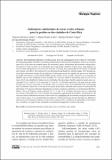| dc.contributor.author | Morales Cerdas, Vanessa | |
| dc.contributor.author | Piedra Castro, Lilliana María | |
| dc.contributor.author | Romero-Vargas, Marilyn | |
| dc.contributor.author | Bermúdez-Rojas, Tania | |
| dc.date.accessioned | 2020-08-31T22:43:28Z | |
| dc.date.available | 2020-08-31T22:43:28Z | |
| dc.date.issued | 2018-08 | |
| dc.identifier.issn | 00347744 | |
| dc.identifier.uri | http://hdl.handle.net/11056/18035 | |
| dc.description.abstract | Abstract: Environmental indicators of urban green areas for management in two cities of Costa Rica. Environmental quality contributes to the physical and mental well-being of the population. In this way, the green areas (GA) of the cities are essential spaces for coexistence, sports, socialization, and recreation, among others.The objective of this research was to determine the environmental conditions of green areas, using indicators as tool for urban management in two cities of Costa Rica. The study area corresponded to the districts of Heredia and Carmen, Costa Rica. The existing GA were determined using Rapid Eye satellite images, 2012 through spatial analysis and remote sensing. Eleven indicators of urban green areas were applied, the species was identified, the height, the diameter at breast height (DBH) and the number of trees in parks and streets were measured. In addition, surveys were conducted to users of public GA, on issues related to accessibility and use of GA. Five types of GA were identified in Carmen and six in Heredia. The percentage of public and private green areas corresponded to 36 % and 64 % in Carmen and 13 % and 87 % in Heredia respectively. The green area per capita (m2/hab) was 24.6 in Carmen and 2.7 in Heredia. Sixty-two species of trees were identified in the Carmen parks
and 23 in Heredia. There were 1 105 trees of 61 species in the streets, sidewalks and avenues of Carmen and 278 individuals of 47 species in Heredia. Regarding the existence of riparian vegetation, it was determined that Pirro, Burrio, Torres and Negritos streams maintain 82, 51, 81 and 14 % of margin protection areas in conforming use. Eleven of the public GA’s were evaluated, nine presented a high physical accessibility. In both districts, the surveyed citizens indicated the necessity to have more GA, highlighting the recreational, ecological and touristic value of these spaces. It is concluded that the indicators of urban green areas showed that there are differences between the environmental conditions in both of the evaluated cities. In addition, the applicability of the indicators is feasible as an input for the sustainable environmental management of urban ecosystems. | es_ES |
| dc.description.abstract | La calidad ambiental contribuye con el bienestar físico y mental de la población. En este sentido las áreas verdes (AV) de las ciudades son espacios esenciales para la convivencia, el deporte, la socialización, y la recreación, entre otros. El objetivo de esta investigación fue determinar las condiciones ambientales de las AV, utilizando indicadores como herramientas para la gestión urbana en dos ciudades de Costa Rica. El área de estudio correspondió a los distritos de Heredia y el Carmen, Costa Rica. Se determinaron las AV existentes utilizando imágenes satelitales Rapid Eye, 2012 mediante análisis espacial y teledetección. Se aplicaron 11 indicadores de áreas verdes urbanas, se identificó la especie, se midió la altura, el DAP y el número de árboles en parques y calles. Además, se realizaron encuestas a los usuarios de las AV públicas, en temas relacionados con accesibilidad y uso de las AV. Se identificaron cinco tipos de AV en el Carmen y seis Heredia. El porcentaje de áreas verdes públicas y privadas correspondió a 36 % y 64 % en el Carmen y 13 % y 87 % en Heredia, respectivamente. El área verde per cápita (m2/hab) fue de 24.6 en el Carmen y de 2.7 en Heredia. Se identificaron 62 especies de árboles en los parques del Carmen y 23 en Heredia. Se contabilizaron 1 105 árboles de 61 especies en las calles, aceras y avenidas del Carmen y 278 individuos de 47 especies en Heredia. En cuanto a la existencia de vegetación ribereña se determinó que los ríos Pirro, Burrio, Torres y la quebrada Negritos mantienen 82, 51, 81 y 14 % del área de protección de sus márgenes en uso conforme. De 11 AV públicas evaluadas, nueve presentaron una accesibilidad física alta. En ambos distritos los ciudadanos encuestados indicaron la necesidad de contar con más AV, resaltando el valor recreativo, ecológico y turístico de estos espacios. Se concluye que los indicadores de AV urbanas evidenciaron diferencias entre las condiciones ambientales en las dos ciudades evaluadas, y la factibilidad de su aplicación como insumo para la gestión ambiental sostenible de los ecosistemas urbanos. | es_ES |
| dc.description.sponsorship | Universidad Nacional, Costa Rica | es_ES |
| dc.language.iso | spa | es_ES |
| dc.rights | Acceso abierto | es_ES |
| dc.rights.uri | http://creativecommons.org/publicdomain/zero/1.0/ | * |
| dc.source | Revista de Biología Tropical vol.66 no.4 1421-1435 2018 | es_ES |
| dc.subject | INDICADORES AMBIENTALES | es_ES |
| dc.subject | ZONAS URBANAS | es_ES |
| dc.subject | COSTA RICA | es_ES |
| dc.subject | COSTA RICAN CITIES | es_ES |
| dc.subject | PARKS | es_ES |
| dc.subject | CALIDAD AMBIENTAL | es_ES |
| dc.subject | URBAN GREEN AREAS | es_ES |
| dc.title | Indicadores ambientales de áreas verdes urbanas para la gestión en dos ciudades de Costa Rica | es_ES |
| dc.type | http://purl.org/coar/resource_type/c_6501 | es_ES |
| dc.description.procedence | Escuela de Ciencias Biológicas | es_ES |
| dc.description.procedence | Escuela de Ciencias Geográficas | es_ES |


